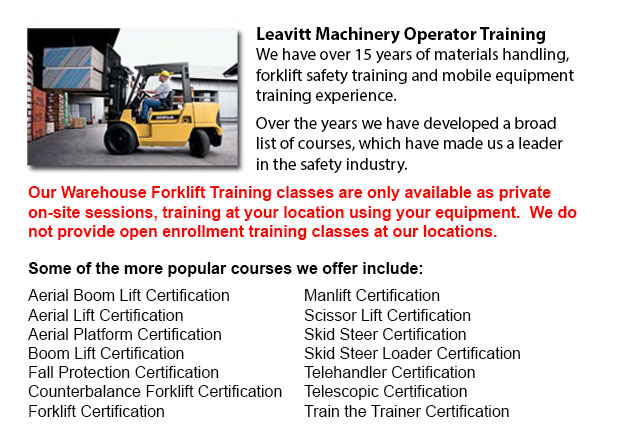
Nanaimo Warehouse Forklift Training Programs - Warehouses can be industrial, commercial or retail facilities. Their function could vary from product distribution to retailing bulk products. Regardless of the kind of warehouse, workers in warehouse settings should be trained properly in safety procedures related to material handling and storage, conveyor systems, loading docks, and forklifts and pallet jacks. Good housekeeping is vital to a safe and orderly warehouse setting.
The loading dock system is normally build into the warehouse at a height from the ground making it easy to move things coming in and moving out of the warehouse. Employees will also unload and load materials and merchandise from the ramps and elevated docks. Particular attention should be paid to safety habits throughout this stage. In order to prevent falls, install yellow striping along the edge of docks and ramps. Pay attention to the area all-around delivery trucks which are parked at the loading dock, specifically the area between truck and dock. Be certain that while unloading, truck wheels are chocked.
To distribute products inside the facility, some warehouses use a conveyor system. These systems are designed with moving belts and wheels that can pose a pinch point danger. Keep hair and parts of the body well away from conveyors to prevent injury. Elevated conveyors pose a hazard to personnel beneath if safety nets are absent. Employees need to know how to stop conveyors in the event of emergency. Be aware of the location of off switches and emergency stop buttons. When servicing conveyors, lock out/tag out measures are mandatory.
Forklifts and pallet jacks are designed to move materials around the warehouse. Operators of forklifts are required to take training and be given certification. Pallet jack operators do not need certification, but must be trained on the machinery. Training courses instruct operators in the correct ways for hoisting materials and moving them to their assigned place. Neither pallet jacks nor forklifts should ever be made use of to transport or lift workers.
Rack system and storage shelving help to create an orderly and efficient work area if they are sturdy, braced, and allow enough room for individuals and machines to pass. Slow and careful placement of good is needed to prevent accidents caused by products falling off the facing aisle. Aisles must be kept clear by storing products flat and in the shelving units. Pallets are made use of for stacking products. They must be in good condition, and palleted products should be baled or shrink-wrapped, whenever possible.
PPE or personal protective equipment must be worn when required to help protect the employees' heads, limbs, hands and feet. Bump caps or hard hats, gloves and steel-toed shoes are common PPE.
Slippery floors that are pocked with pits and dents can present significant dangers, making good housekeeping very vital. Warehouse docks and floors must be clear of debris oil and dirt. The space must be kept clear of boxes, baling materials and garbage.
-
Nanaimo Boom Lift Certification
Nanaimo Boom Lift Certification - Using elevated work platforms allow for maintenance operations and work to be carried out at elevated work heights which were otherwise not reachable. Workers making use of scissor lifts and boom lifts can learn how... More -
Nanaimo Boom Lift Safety Training
Nanaimo Boom Lift Safey Training - Boom lifts are a kind of aerial lifting device or elevated work platform which are commonly used in industry, warehousing and construction. Boom lifts could be utilized in practically whichever environment because o... More -
Nanaimo Loader Operator Training
Nanaimo Loader Operator Training - Loader Operator Training - Forklift training is a prerequisite within North America and is intended to prevent workplace death and injuries. Lift truck training provides driver training intended for forklift operato... More -
Fall Protection Certification in Nanaimo
There are high numbers of injuries at work associated to falling and lots of fall-related deaths reported each and every year. Most of these instances might have been prevented with better training, better measures in place, and by properly equipping... More -
Nanaimo Crane Ticket
Nanaimo Crane Ticket - The modern version of a crane can be either complex or simple, and cranes vary based on their use. Mobile cranes, for example are rather simple. A telescopic boom or steel truss mounts its movable platform. A system of levers o... More -
Operator Safety Certification | Re-Qualification Certification | In-House Instructor Certification in Nanaimo
Lift trucks are used in practically all industrial construction sites and in warehouse operations and in boat yards. The reach feature of a forklift is a very important part utilized in several applications like when a shelving system is being used t... More -
Aerial Lift / Boom Lift / Man Lift / Scissor Lift Certification in Nanaimo
Scissor hoists are lift tables which lift up materials and individuals and supplies vertically. They are normally used in construction, commercial and industrial environments. A common use of scissor hoists is for lowering or lifting construction sup... More -
Crane / Overhead Crane / Self-Erect Crane / Truck Mounted Crane / Hydraulic Cranes Certification in Nanaimo
Bridge cranes or likewise called overhead cranes are a type of industrial material handling crane utilizing a line and hook apparatus that runs on a horizontal beam running along two widely separated rails. Several overhead cranes can be seen inside... More

Forklift Certification Nanaimo
TOLL FREE: 1-888-254-6157
Nanaimo, British Columbia
forkliftcertificationnanaimo.com
Email Us
About Us


